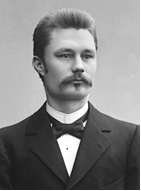Edvard Isto
| Edvard Isto | |
|---|---|
|
Photograph by Daniel Nyblin | |
| Born |
November 28, 1865 Alatornio |
| Died |
October 14, 1905 (aged 39) Helsinki |
Edvard Isto, or Eetu Isto (1865-1905) was a Finnish artist, best known for his patriotic anti-Russian painting, "The Attack", which was widely reproduced in its original form and in variations.
Biography
.jpg)
He was the youngest of nine children born to a family of farmers, and the only one who attended school; the nearest of which was six miles away. Even so, he was unable to continue beyond the elementary grades, because the nearest secondary school was too far away, in Oulu. When he turned eighteen, he went to Övertorneå, in Sweden, to work at a decorating company owned by one of his cousins.
He moved to Helsinki in 1888, where he studied art and design at what is now the "Aalto University School of Arts, Design and Architecture", but could only advance so far, due to his lack of education. Meanwhile, he supported himself by painting and decorating. Among others, he worked for the architect Karl August Wrede. After this experience, he was able to return to the School of Arts and complete his studies. He may have attended some classes at the Academy of Fine Arts, and began producing his first canvases.
In 1895, he applied for and received a government grant that enabled him to travel to Berlin, where he studied at the Prussian Academy of the Arts. Although he was forced to support himself by house painting and decorating again, he had more time to devote to serious work, especially portraits.
The Attack
While there, in response to the Russification of Finland, he painted "The Attack" (Hyökkäys) which shows the Russian eagle attacking the Finnish Maiden. He took it back to Helsinki and displayed it privately at a villa in Kaivopuisto. It may, in fact, have been completed there, as the Maiden resembles the wife of one of Isto's friends. It was reproduced and distributed by the thousands throughout Finland, Germany and Sweden, despite efforts to suppress it.
After a brief return to Berlin, he settled in Alatornio in 1901 where he was a guest of the local vicar and continued to paint portraits; the best-known being that of the politician and educator Mauno Rosendal. In 1902, however, during a political purge, the vicar was exiled to Siberia. Three years later, Isto accompanied two of the vicar's sons on a visit there and contracted typhoid fever during the journey. He returned to Finland, but his health was fragile and he died of pneumonia shortly after his arrival. In 1936, his grave in Alatornio was decorated with a sculpture based on his famous painting.
Further reading
- Pekka Rönkkö, Eetu Isto (1865–1905) ja Hyökkäys (1899), Ars Nordica 2, Oulu, 1990 ISBN 951-749-142-5
External links
| Wikimedia Commons has media related to Edvard Isto. |
- Eetu Isto @ BlogSpot. Includes an appreciation of "The Attack" by Väinö Kokon (head of the Oulun Lyseon Lukio), a photograph of Isto's grave and newspaper clippings.
- "The Attack - a symbol of independence for 100 years"; a brief history of the painting itself, by Raija Forsström from the Helsingin Sanomat
- "The Attack" as a jigsaw puzzle @ Jigidi
